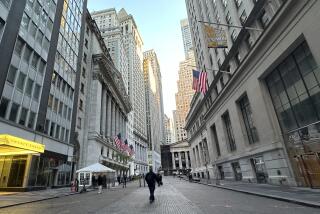Leading Indicators Index Sees No End to Expansion
- Share via
NEW YORK — A key indicator of future economic activity climbed to a 40-year high in November, data released Wednesday showed, suggesting that the economy’s expansion will continue well into the new year to become the longest in U.S. history.
The index of leading economic indicators, a forecast of economic activity over the next three to six months, rose 0.3% in November to 108.3, the Conference Board said.
That is the highest reading since 1959, the first year the index was calculated in a way that is comparable to current figures.
The index is intended to signal trends in economic growth and forecast possible growth or a recession. Economists had expected the index to show a 0.2% rise in November.
The November and October gains followed a decline of 0.1% in September and a flat reading in August, which the board blamed on a severe hurricane season.
But Ken Goldstein, the board’s economist, said the latest reading suggested there had been no fundamental change in the underlying strength of the U.S. economy in the second half of the year.
“Without more evidence of some underlying weakening in economic fundamentals, this expansion will continue well into 2000, setting a record in February,” he said.
Now in its second-longest expansion in U.S. history, the economy will beat that record from the 1960s if the current upturn lasts beyond February.
Six of the 10 factors that make up the leading index rose in November, led by stock prices and consumer goods orders. Fueled by strong gains in stock prices, consumer demand has been one of the key engines of red-hot U.S. growth.
The U.S. economy expanded by 5.7% in the third quarter of the year, up sharply from the 4.8% growth rate in the second quarter.
Few economists expect it to slow down much any time soon. U.S. consumer confidence is at its highest level in more than a generation, and rising interest rates--the Federal Reserve raised rates three time this year to prevent the economy from overheating--have yet to have any noticeable effect on their spending patterns.
First estimates for growth in the year’s final quarter are due early next year.
The longest economic expansion in U.S. history lasted 106 months, from February 1961 until December 1969. The current expansion, which began in March 1991, would match that record if it continues through January.
Andrew Groat, an economist at Merrill Lynch, said continued strong economic growth makes it likely the Fed will raise rates in the new year. The Fed’s main cause for concern is the tight labor market, which could lead to wage inflation, Groat said.
(BEGIN TEXT OF INFOBOX / INFOGRAPHIC)
Index of Leading Economic Indicators
*
Seasonally adjusted index; 1992= 100.
*
November 108.3
*
Source: Conference Board
More to Read
Inside the business of entertainment
The Wide Shot brings you news, analysis and insights on everything from streaming wars to production — and what it all means for the future.
You may occasionally receive promotional content from the Los Angeles Times.










